We were met in Split by an auspicious orange moon.
First stop north, Krka National Park.
Droves of tourists snaking around the walkways through clear turquoise water on limestone pavements. But the wildlife seemed oblivious to this.
Fish were in abundance, but by far the most common was the greenish Illyrian Ide (Leuciscus illyricus) - previously called Yugoslavian Dace, the old name of the area to which it is endemic.There are over 20 species of Leuciscus (chub and dace) in Europe, and Croatia has more than its fair share - presumably the waterways cut through limestone created isolated populations which evolved. For comparison, here is the Common Chub (Leuciscus cephalus) photographed in my local park:
And cryptically resting on the river floor, an endemic goby?
A Marsh Frog (Pelophylax ridibundus) watches over the river.
The gap between the eyes identifies this dragonfly as a Gomphid. It is the aptly named Small Pincertail (Onychogomphus forcipatus).
This Libellulid dragonfly is the Blue Chaser (Libellula fulva).
By far the most common damselfly, the Beautiful Demoiselle (Calopteryx virgo). In this case the south-western Europe sub-species meridionalis, the wings of the male pigmented metallic cobalt blue except for at the bases.
This is not a different species, it is a female Beautiful Demoiselle.
This small damselfly belongs to the Featherlegs family (Platycnemididae). It is the Blue Featherleg (Platycnemis pennipes).
The dappled woodland shade around the river is habitat to a number of butterflies, from different families. Satyrids usually have brownish wings with eye spots (with the exception of marbled whites), and the host plants are normally grasses. The Woodland Grayling (Hipparchia fagi) is cryptic against tree bark...
...as can be the Speckled Wood (Parage aegeria) on the leafy floor.
Nymphalids are more bright and showy. The Southern White Admiral (Limenitis reducta) is also at home in woodland clearings.
On the road north, and a stop for lunch. I took lamb, but the pig also looked good.
Next stop, Lake Vrana.
Great views of Great Reed Warblers singing their hearts out.
And this beauty, another showy Nymphalid, the Spotted Fritillary (Melitaea didyma).
In the car park some Scarab beetles were taking time out from eating dung to lark about in the grass. Maybe species of Aphodius.
A longhorn beetle, Purpuricenus budensis.
Hardly noticeable at our feet, a praying mantis nymph.Next day, we rose early in Starigrad and drove up into the hills around the Paklenica National Park.
Our mission, to find the bird we had come to Croatia to see: the Rock Partridge (Alectoris graeca), which none of us had seen before. It is found throughout the Balkans and even up into Switzerland - but it is an elusive bird, and here we were meant to have a good chance to see it.
First a false alarm, as a hare hopped out of the scrub into the road.
But later, we followed a startled flight into the shadows - and there, hopping along the rocks, a Rock Partridge.
And then we see it is a female - as a young chick runs into the light, trying to keep up with mother.
In the trees other birds are active. A contrast of black and white, a male Black-eared Wheatear (Oenanthe hispanica). The white is usually tinged brown, but this is the paler eastern race melanoleuca, and the coloured plumage has worn away over the summer.
A chunky billed Eastern Orphean Warbler (Sylvia crassirostris).
Red-backed Shrike (Lanius collurio).
A distant glimpse of an Eastern Subalpine Warbler (Sylvia cantillans).
We were watched from a high point by a Blue Rock Thrush (Monticola solitarius).
Dalmation Wall lizards (Podarcis melisellensis) scuttled into the undergrowth. This species is found only on the Dalmatian coast. It seems as if someone has taken a brush and painted the back of the female green and the underside of the male orange.
Back to the Satyrids. A Pearly Heath (Coenonympha arcania). One of my favourites.
Large Wall Brown (Lasiommata maera).Great Sooty Satyr (Satyrus actaea).
The Lycaenids (Blues, Hairstreaks and Coppers) are generally quite small, and sun loving. Much time can be spent looking at the wing patterns of individuals - in search of rare local species - which turn out to be Common Blues (Polyommatus icarus). We saw the southern European celina form. The larvae feed on Leguminous plants.
The Blue-spot Hairstreak (Satyrium spini) uses Buckthorns (Rhamnus spp.) as host plants.
A day flying Geometrid, the Chimney Sweeper (Odezia atrata).
An Arctiid moth, the Cream-spot Tiger (Arctia villica). It is nocturnal, but rests on leaves during the day. You might think it risks being eaten by birds. But Arctiids can assimilate toxic chemicals from their host plants. Their predators learn to avoid the bright wing patterns, which are said to be 'aposematic' - an honest signal of a bad taste. Arctiids can also make ultrasonic vibrations, used by bats for recognition in the dark.
This is a Fairy Longhorn (Adelidae) 'micromoth'. Probably a species of Adela.
I managed to take a better picture of the Egyptian Locust (Anacridium aegyptium) than I did in Spain earlier this year.
Steve attracted a predatory Assassin Bug (Reduviidae), Rhynocoris rubricus.
He also noted something falling out of the sky next to the car. It looks like an Orphean Warbler chick. There were no trees around the car, so maybe it was dropped by a predatory bird.From the hills above Starigrad you can look across to Pag Island, a harsh habitat of limestone rocks.
But even here small clumps of plants support herds of herbivores - not mighty antelopes, but magnificent grasshoppers. There are 11 species of Stenobothrus in Western Europe. Here is one of them - maybe the Southern Grasshopper S. fischeri.
This Woodland Grasshopper, Omocestus rufipes, is nowhere near a wood. The males are unusually black, whereas the females are a more traditional green and brown.
Stone Grasshoppers (Pamphagidae) live, as you'd expect, in dry places. They are armoured Samurai. Localized species of Prionotropis occur over the Mediterranean, presumably the result of populations isolated by some past climatic event. P. hystrix is restricted to the north-east coast of the Adriatic.
As well as grasshoppers, there were Bush-crickets (Tettigoniidae). The Spur-winged Spiny Bush-cricket, Gampsocleis abbreviata, is found in the south-west Balkans. Here is a nymph...
...and here an adult male - it should be a model for Pixar.
On the small clumps of daisies that grow out of the rocks sit Blister Beetles (Meloidae) - called so because they secrete a blistering agent, cantharidin. The bright orange colour is aposematic - as in the Tiger Moths. But this species, Mylabris variabilis, is also a predator - and the larvae feed on grasshopper eggs!
Other predators roam the plain. An aptly named Wolf Spider, Lycosidae, (Hogna radiata).
Jumping Spiders, Salticidae, have four pairs of eyes - the better to see you with! Philaeus chrysops males have bright red abdomens, whilst the females are dull brown.
At the top of the food chain, the Tawny Pipit (Anthus campestris).
But all is not dry. Drifting over from the pond on the horizon, a female Black Pennant (Selysiothemis nigra). Note the diagnostic 'equals' signs at the end of the wings. Like the Chaser in Krka, it is a Libellulid - found mainly in the Middle East, but occurring also in coastal pockets around the Mediterranean.
The next day we drove through the high Velebits, on the way to Rab island.
The meadows punctuated pink by the Early Marsh-orchids (Dactylorhiza incarnata)...
...Fragrant Orchids (Gymnadenia conopsea)...
...and Globe Orchids (Traunsteinera globosa).
In patches of woodland, the Orange Lily (Lilium bulbiferum).
And flying by the road, a Papilionid - the Scarce Swallowtail (Iphiclides podalirius).
Of the Pierids, we saw Cleopatra (Gonepteryx cleopatra) - it shares Rhamnus as a host plant with the Blue-spot Hairstreak...
...and, I think, a Mountain Small White (Artogeia ergane) - difficult to be sure without seeing the spotty forewings.
For the Blues, A Little Blue (Cupido minimus). Its host plant is Kidney Vetch (Anthyllis vulneraria).Is this a Mountain Alcon Blue (Maculinea rebeli), or a 'normal' Alcon Blue (Maculinea alcon)? They both have mountain pedigrees, with Gentians as their host plants.
The Nymphalid, High Brown Fritillary (Argynnis adippe). Like many of the larger bright orange Fritillaries, its caterpillars feed on Violets. How sweet is that?
When is a Fritillary not a Fritillary? When it's Duke of Burgundy Fritillary (Hamearis lucina). Its not a Nymphalid, but the only member of the Riodinidae (Metalmarks) - more closely related to the Lycaenids.More Satyrids: A Bright-eyed Ringlet (Erebia oeme)...
... and Chestnut Heath (Coenonympha glycerion).
Hisperids (Skippers) are not good at holding their wings out when they settle, and look a little scruffy. You have to learn to love them. This is the Small Skipper (Thymelicus sylvestris). Also a grass eater.
Burnets (Zygaenidae) must be the most seen day-flying moths. Like Tiger Moths they are toxic to predators, and their bright colouring is aposematic. This is the Transparent Burnet (Zygaena purpuralis), lathyri sub-species. It uses Thyme as a host plant.
Scarabid beetles also like flowers. The Rose Chafer (Cetonia aurata)...
...and Oxythyrea funesta.
Overlooking the proceedings, an Ortolan Bunting (Emberiza hortulana).
Next stop, the island of Rab - as guests at the family house of our old colleague and friend Damir Ivacic.
Damir took us out on a boat, from which we watched rafts of Yelkouan Shearwaters (Puffinus yelkouan).
We moored at Kalifront - a unique habitat, it is one of the best preserved Holm oak (Quercus ilex) woods in the Mediterranean.
The Italian Wall Lizard (Podarcis sicula) has many dozens of sub-species over the Mediterranean - and I've no idea which one this is. This diversity is believed to be due to natural isolation events and introductions by man. In 1971, ten adults were transported from the Croatian island of Pod Kopište to Pod Mrčaru (3.5 km). Since then, the lizards on Pod Mrčaru have become larger, with shorter hind limbs, run more slowly and respond less to simulated predatory attacks. These are attributed to relaxed predation intensity and a shift from an insect to plant diet. To adapt to their new diet, the lizards have developed cecal valves, containing nematodes, which slow down food passage and provide fermenting chambers to convert cellulose to digestible nutrients. This is an adaptive novelty, a brand new feature not present in the ancestral population and newly evolved in these lizards.
We saw many Gypsy Moth caterpillars (Lymantria dispar) climbing the trees in search of foliage.Ground Beetles (Carabidae) are fierce predators, and in relation to body length are among the fastest animals on Earth. But they are not always on the ground. On the trees we saw many Forest Caterpillar Hunters (Calosoma sycophanta), voracious consumers of caterpillars - especially Gypsy Moths!
Also Lacon punctatus, a Click beetle (Elateridae) - so called because they have a spine on the prosternum which can be snapped into a corresponding notch on the mesosternum to produce a violent 'click' that can bounce the beetle into the air. Good for avoiding predators, and righting itself when on its back.
Planthoppers are little known insects. This looks like an Issid, with its 'broad shoulders'.
On the edge of the wood, the aptly named Ilex Hairstreak (Satyrium ilicis) feeding on flower nectar. They will lay their eggs on the oaks, the larval hostplants.
Also taking a nectar break between hunting for grasshoppers to feed its larvae, a Sphecid digger wasp - Sphex funerarius. Before taking paralysed grasshoppers into the nest, the female Sphex first inspects the nest, leaving the prey outside. If you move the grasshopper while she is inside she will find it and drag it back to the entrance - then check the nest again. She may do this indefinitely - it is not thoughtful behaviour, it is a mindless 'behavioural programme' which is reset each time. There's no such thing as a free lunch, or free will!
Into the hills, we see Great Banded Grayling (Kanetisa circe)......Large Wall Brown (Lasiommata maera)...
We waved goodbye to Rab from the ferry to the mainland. Hitching a ride with us was a Musk Beetle (Aromia moschata).
Thanks to Damir for a roof over our heads, for catching and cooking our fish, for the Croatian songs, for everything.
And now westwards, inland, to the Plitvice Lakes National Park.At the lakes, you can be shuttled by bus and boat from restaurant to ice cream stall. Or, you can drive out of the park to the meadows that surround them - and experience pure joy.
Among the carpets of daisies and yellow rattle, orchids poke their heads. Pyramidal orchid (Anacamptis pyramidalis)...
...and Bee Ophrys (Ophrys apifera).On the edge of the meadows, Hungarian Iris (Iris variegata).
More meadows, more flowers, more insects. The delicate-winged Clouded Apollo (Parnassius mnemosyne). Mainly found in south-east Europe, its caterpillars feed only on Corydalis.
A Black-veined White (Aporia crataegi). It uses wild fruit trees as host plants - such as apples, pears, cherries, peaches and plums.
Many butterflies abandon flowers to feed on the earth - known as 'mud puddling' - sucking up needed salts. I think this is a Silver-studded Blue (Plebejus argus).
The Mazarine Blue (Cyaniris semiargus) - also a guest in my garden. The larval plant is Red Clover (Trifolium pratense) - which it must share with my Guinea Pig, Darwin.
A male Purple-shot Copper (Lycaena alciphron).
Amanda's Blue (Agrodiaetus amanda). The host plants are vetches (Vicia).
The Large Blue (Maculinea arion) is an iconic butterfly - symbol of a complex ecosystem maintaining great beauty. The female lays her eggs on Thyme (or Marjoram in warmer areas). When the caterpillars reach third instar they drop off the plant, to be picked up by Mymica ants (which they mimic) and carried to the nest - where they will eat the ant eggs and larvae, or beg the other ants for food like a 'cuckoo'.A brown Blue - the Scarce Copper (Lycaena virgaureae). It uses Docks (Rumex) as host plants.
More of those large Fritillaries that use Violets as a host plant. The Dark Green Fritillary (Argynnis aglaja)...
A Heath Fritillaries (Mellicta athalia) perching and 'mud puddling'.
...the Niobe Fritillary (Argynnis niobe)...
...and a Silver-washed Fritillary (Argynnis paphia) - mistaking a truck's orange rear light for a mate.A Heath Fritillaries (Mellicta athalia) perching and 'mud puddling'.
The Safflower Skipper (Pyrgus carthami) has Cinquefoils (Potentilla) as host plants.
More Burnet moths. The Six-spot Burnet (Zygaena filipendulae)...
...and the Slender Burnet (Zygaena loti).As well as the patterned Burnet Moths, Zygaenidae also contains the Forester Moths, which are most often metallic green. There are a dozen similar species. Here is one.
The Nine-spotteds (Amata) are in a closely related group to the Tiger Moths. Species can be separated on wing pattern. I think we saw two species - Amata phegea...
...and Amata kruegeri.
You decide.
And you've guessed it, Nine-spotted are also aposematic. But it doesn't end there. They look remarkably similar to the aposematic Burnet moth Zygaena ephialtesis, despite being from different families - here's a picture of Z. ephialtesis from the web:
It seems they mimic each others warning colouration. That means they both benefit from a predator learning just one pattern. It's called Müllerian mimicry, after the man who first proposed it. The young Fritz Müller was unconventional for early 19th century Prussia - an atheist who believed in free love - and he did not graduate from his medical degree because he refused to swear the religious oath. Fed up, he emigrated to Brazil at the age of 31. Looking at a photo of him I'm skeptical as to how much free love he actually received.
Other moths were out and about: the Burnet Companion (Euclidia glyphica), a Noctuid......and the Common Heath (Ematurga atomaria), a Geometrid.
And the air is filled with the singing of herbivores. The Large Banded Grasshopper (Arcyptera fusca). The males have long wings - whereas the females wings are reduced and cannot be used for flight, known as brachyptery.
But in these meadows it is mainly Bush-crickets that we see. The Wart-biter (Decticus verrucivorus) was used by people in olden times, as the name states.Pholidoptera frivaldskyi.
Psorodonotus illyricus sits on Steve's finger. It's one of three closely related species in the Balkans.
The Large Saw-tailed Bush-cricket (Polysarcus denticauda). In high density areas dark morph males are produced, as seems to be the case here.
Owlflies (Ascalaphidae). They look like dragonflies and hunt like dragonflies. This is Libelloides macaronius.
From the Heteroptera, a Minstrel Bug (Graphosoma italicum).
A Chrysolina Leaf Beetle blocks an ant.
Another Scarab, Hoplia argentea, losing its green scales. Note above it, the Flower Crab Spider (Misumena vatia) - a cryptic predator waiting for prey.
Walking to dinner in the grounds of the hotel we saw what looks like a young Chaffinch splayed out on a wall. Fear not, it was just a fledgling crash land. He picked himself up and flew away.
Another 'birding' trip over. What a delight of diversity, including views of over 100 birds and 50 butterflies. Until next year, Živjeli!

























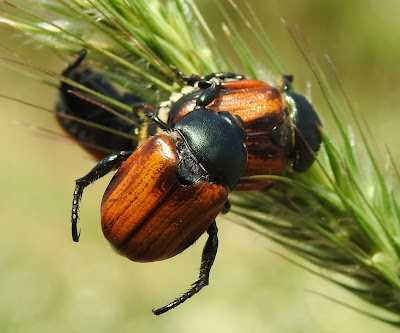


























































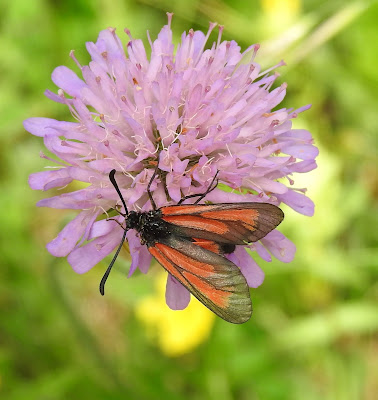







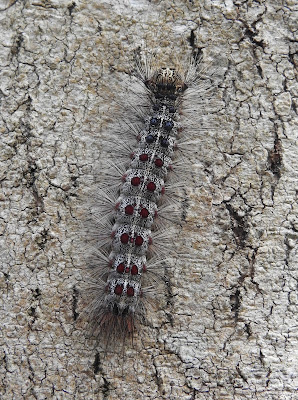

















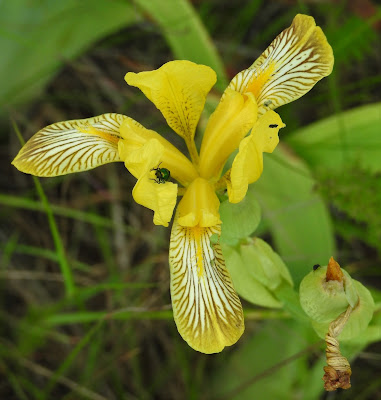

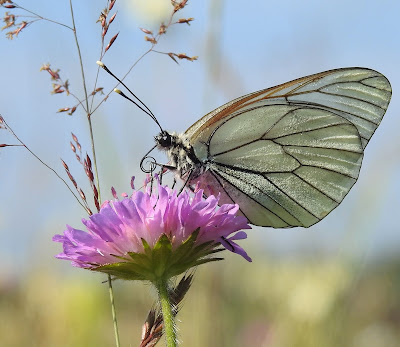









































Slurp! Worth the wait!����
ReplyDeleteGood customer feedback always appreciated.
Delete